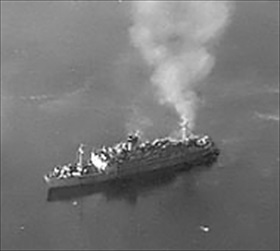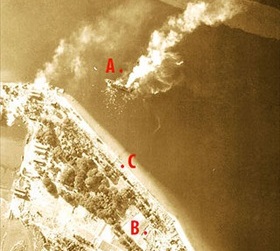U.S. NAVY HELLCATS BOMB HELLSHIP ENOURA MARU
Kaohsiung, Japanese-Occupied Taiwan • January 9, 1945
World War II in Asia began with Japan’s conquest of Northeast China in 1931. Rogue elements of the Kuantung Army (Japan’s army in China) created an incident on a Japanese-owned railline near Mukden (now Shenyang) and used it as an excuse for military operations in the rest of Manchuria. That action, followed by Japan’s establishment of its puppet sate of Manchukuo in Manchuria six month later, marked the beginning of the unofficial war between China and Japan. It morphed into the Second Sino-Japanese War, which saw the conquest of the coastal city of Shanghai and the Nationalist Chinese capital of Nanking (Nanjing) in 1937, and it spilled over into the surprise Japanese attack on the U.S. Pacific Fleet at Pearl Harbor, Hawaii, and the invasion of European overseas territories in Southeast Asia at the end of 1941.In the wake of Japan’s military whirlwind conquest and occupation of Southeast Asia, the Japanese Army interned tens of thousands of prisoners of war in various POW camps in occupied Hong Kong, Singapore, Malaysia, Burma, the Philippines, the Dutch East Indies (present-day Indonesia), and in Japan’s puppet state of Manchukuo in Manchuria. As early as May 1942 the Japanese began transferring POWs by sea to new locations, principally Japan, where they were used as slave labor in dangerous mines or factories under the most deplorable conditions. (Angelina Jolie’s 2014 theatrical release, Unbroken, depicts the plight of Louis Zamperini and other Allied POW slave laborers in Japan.) Known as “hellships,” these prisoner transport ships—formerly merchant vessels once used for hauling cargo repurposed into pens for human chattel—carried men crammed below decks with little air, food, or water for journeys that could last for weeks. Many transported prisoners died due to asphyxia, starvation, or dysentery.
The Allies considered these unmarked prisoner transports to be fair targets. As many as 19,000 of the estimated 21,000 Allied POWs who died at sea were killed by friendly fire when their transport ships were attacked by Allied submarines and aircraft. On this date, January 9, 1945, the Japanese hellship Enoura Maru was bombed and disabled by U.S. Navy F6F Hellcat fighter-bombers while in Kaohsiung (Takao) harbor in southwestern Taiwan, killing about 350 persons. The unlucky Enoura Maru prisoners were part of a larger continent of 1,900 Japanese civilians and military personnel who had left the Philippine capital of Manila on board another unmarked vessel, the Ōryoku Maru, on December 13, 1944. Two days later the ship was sunk by U.S. carrier-based aircraft near a Japanese naval repair station in Subic Bay, which lies just north of the Bataan Peninsula opposite Manila. The bombing of the Ōryoku Maru killed hundreds; many were shot dead in the water as they tried making their escape from the burning transport ship (see photo below).
About 1,000 of December’s survivors of the Ōryoku Maru’s bombing and sinking were loaded onto the Enoura Maru and the smaller Brazil Maru. Survivors of the Ōryoku Maru who were lucky enough to survive the U.S. Navy’s attack on the Enoura Maru in Taiwan’s Kaohsiung harbor on January 9, 1945, were hustled into the cramped holds of the Brazil Maru, which reached Moji (now part of Kitakyūshū) on Japan’s Kyūshū Island, on January 29. Only 550 of the 900‑plus POWs who sailed from Kaohsiung to Moji earlier in the month were still alive at the end January 1945; 150 more men died in Japan, Taiwan, and Korea in the coming months, leaving only 403 survivors of the original 1,620 who had left Manila aboard the Ōryoku Maru on December 13, 1944, to be liberated from Japanese POW camps in Kyūshū, Korea, Manchuria, and Taiwan in August and September 1945.
![]()
Japanese Hellships: POW Transport Ships
 |  |
Left: The Ōryoku Maru was a 7,365‑ton Japanese passenger cargo liner, which was commissioned by the Imperial Japanese Navy during World War II as a troop transport and prisoner of war transport ship. Generally, hellships (there were over 200) were former passenger ships or old cargo ships into whose hulls the Japanese military crammed thousands of POWs under the most inhuman conditions for transport to Japan or other Japanese-occupied territories. On her last mission the Ōryoku Maru transported 1,620 survivors of the 1942 Bataan Death March, Corregidor (1942), and other battles. About 270 died aboard ship on its last voyage, victims of suffocation or dehydration; victims of bomb and strafing attacks by U.S. carrier-based planes between December 13 and 15, 1945; or drowning victims while escaping the sinking vessel.
![]()
Right: The Ōryoku Maru burning near the Japanese naval repair station at Olongapo in Subic Bay after the attack by U.S. carrier-based F6F Hellcat fighter-bombers from the USS Hornet on the morning of December 15, 1944. A direct hit on the aft hull killed over 250 Allied POWs. The ship caught fire and sank. Seen in this reconnaissance photo taken from a Hellcat are the splashes created by surviving POWs swimming ashore from the burning Ōryoku Maru (labeled A); the location of the former tennis court (B) on which the POWs from the Ōryoku Maru sinking were held in unsanitary conditions for six days with little food and drinking water before boarding the unmarked Enoura Maru and the Brazil Maru at San Fernando, La Union, in northwestern Luzon for the perilous voyage to Kaohsiung, Taiwan; and the site of the Hellships Memorial (C). The memorial at the Subic Bay Historical Center in the Philippines, 68 miles from Manila, honors the sacrifice made by the thousands of Allied POWs of the Japanese who were lost on hellships.
Documentary About Thousands of British and Dutch POWs Transported by Japanese Hellships to the Moluccas (Maluku Islands) to Build Japanese Airfields
![]()

 History buffs, there is good news! The Daily Chronicles of World War II is now available as an ebook for $4.99 on Amazon.com. Containing a year’s worth of dated entries from this website, the ebook brings the story of this tumultuous era to life in a compelling, authoritative, and succinct manner. Featuring inventive navigation aids, the ebook enables readers to instantly move forward or backward by month and date to different dated entries. Simple and elegant! Click
History buffs, there is good news! The Daily Chronicles of World War II is now available as an ebook for $4.99 on Amazon.com. Containing a year’s worth of dated entries from this website, the ebook brings the story of this tumultuous era to life in a compelling, authoritative, and succinct manner. Featuring inventive navigation aids, the ebook enables readers to instantly move forward or backward by month and date to different dated entries. Simple and elegant! Click 











